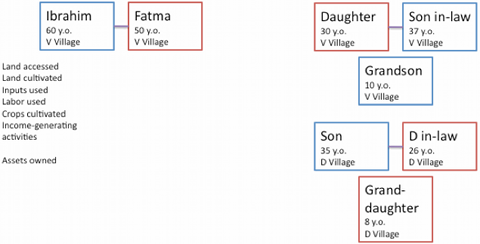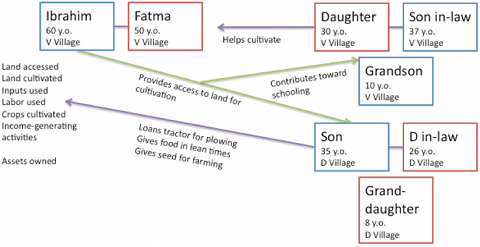Network Analysis
- Objective: Understand key relations and support networks beyond the household to understand household access to – and demands on – resources.
- Materials/Preparation: Flipchart papers, pens, markers. Select a sampling of households from across well-being categories, and set up an appointment with households (most suitably within their homes).
- Participants: Individuals across gender, and well-being groups.
Steps
Following introductions and presentation of the objective, the interviewer and note-taker site at a level equal to the interviewee.
The facilitator then asks who are the different members of the household – their age, location, relationships (marital status, etc.). Each is mapped onto flipchart paper.

Starting with the interviewee, the facilitator asks about his or her income generating and agricultural activities. The facilitator should probe into how much land they own, cultivate, what crops, inputs used, and other livelihood activities. Each is drawn on the flipchart.

If there is clearly a food deficit in the analysis, ask how do households make up for the shortage? Are there other income earning activities or protection mechanisms within the network or community?
Beyond the interviewee him/her-self, probe into:
- What is happening to the children? Are they in school? What costs are involved and how are they paid?
- What do other members in the network do? How do they contribute to the livelihoods of the interviewee? And how does the interviewee contribute to their livelihoods?

Variation (Bangladesh)
Facilitators first asked kin elders:
- Who is the most influential family within the kinship cluster (this person generally owns considerable resources, controls key decision-making bodies and has important alliances with outside elites).
- From this person, facilitators worked with kin elders to map out the relationships and membership of each person within the kin grouping.
Similar to above, once the genealogy is mapped, teams probe into how the kin group operates in terms of how members support one another politically, economically and socially. In probing, be sure to understand the roles of both men and women across the geneology, and relationships among women, men and between women and men.
Related Tools
Resources
- M Drinkwater (2010). Guidelines for Livelihood Network Analysis. Regional Capacity-Building Initiative in Situational Analysis. CARE International – East / Central Africa Regional Management Unit.
- B Bode (2006). Disaggregating Community through Social Analysis. CARE Bangladesh.
